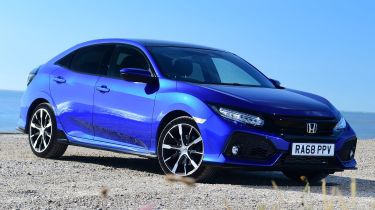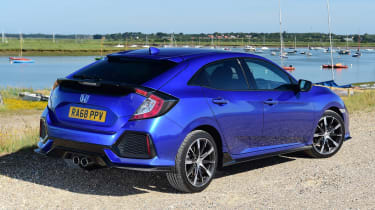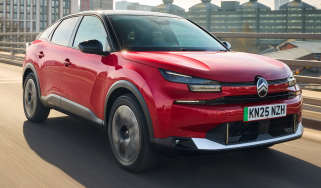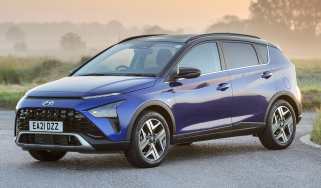Used Honda Civic review
A full used buyer's guide on the Honda Civic covering the Civic Mk10 (2017-date), Civic Mk9 (2011-2015) and Civic Mk8 (2005-2011)
The year 2022 marks 50 years since the original Honda Civic arrived, and there have been 10 generations of this globally popular family car. When the Mk1 model made its debut in 1972 it was revolutionary for Honda, and it sold well around the world thanks to its excellent reliability, frugal engines and generous standard equipment.
Later on the Civic got much more sporty, with the introduction of a Type R edition for the sixth-generation car in 1997. This halo model has remained a constant ever since, but the key selling points for most buyers of the standard versions are low running costs, dependability and decent value for money. Those traits are readily available elsewhere nowadays, but that doesn’t stop the Civic from still being a sound second-hand buy.
Models covered
- Honda Civic Mk10 (2017-date) - Mk10 version of family hatch and saloon offers practicality plus a good drive.
- Honda Civic Mk9 (2011-2015) - Sharp-looking hatchback is a practical, reliable family car.
- Honda Civic Mk8 (2005-2011) - The eighth-generation is a strong choice for used car buyers.
History
The Mk10 Civic arrived in the UK in April 2017, with either a 127bhp 1.0-litre three-cylinder or 179bhp 1.5-litre four-cylinder petrol engine (both turbocharged); the 315bhp Type R joined the range in July 2017 with a turbocharged 2.0-litre powerplant.
Used - available now

2021 Honda
Civic
36,874 milesManualPetrol1.5L
Cash £16,800
2021 Honda
Civic
56,617 milesManualPetrol1.0L
Cash £10,587
2021 Honda
Civic
28,292 milesManualPetrol1.5L
Cash £17,200
2021 Honda
Civic
69,112 milesManualPetrol1.5L
Cash £13,587All Civics had a petrol engine until March 2018, when a 118bhp 1.6-litre diesel joined the range, initially only with a six-speed manual gearbox; a nine-speed automatic transmission was offered with the diesel from August 2018. A month later, a four-door saloon arrived; up to now all versions were five-door hatchbacks, because unlike the Mk9 there was no estate option.
A revised Civic appeared in January 2020 with LED headlights as standard, fresh alloy wheel designs, updated infotainment and extra exterior colour choices.
Which one should I buy?
The diesel engine is still easy to recommend if you cover lots of miles, but both petrol units are nice to use and muscular enough; if you’re on the motorway a lot we’d steer you towards the 1.5-litre, though. The manual gearbox is much nicer to use than the CVT , which like most such transmissions is best suited to urban driving.
Entry-level S versions come with adaptive cruise control, steel wheels, automatic headlights and autonomous emergency braking. SE adds 16-inch alloys, climate control, front and rear parking sensors and a DAB radio, while SR trim brings 17-inch rims, dual-zone climate control, automatic wipers, sat-nav and a rear parking camera. EX gets leather trim, heated front seats, an opening glass roof and adaptive suspension, and Prestige adds heated rear seats.
Alternatives to the Honda Civic Mk10
The Civic has some very stiff competition, not least from the multi-talented Volkswagen Golf, which comes with excellent engines and transmissions, impressive build quality plus decent dynamics. The Ford Focus is another heavyweight that’s plentiful, great to drive, very practical and fine value for money as a used buy. The Ford also has a wide model range, just like the Vauxhall Astra, which is readily available and top value.
A less-obvious option is the Mazda 3, which feels like a premium car inside, with superb build quality and plenty of standard kit. The SEAT Leon offers most of the best bits of a Golf in a cheaper package, while other alternatives include the Volvo V40, Peugeot 308, Kia Ceed and Hyundai i30.
What to look for
Back seats
The Civic Mk9 featured Honda’s brilliant flip-up ‘Magic’ rear seats, but this 10th generation had to do without.
Sensors
The standard Civic Type R has no front or rear parking sensors. The GT gets these, though, plus a better infotainment system.
Towing
The most any Civic can haul is 1,400kg. CVTs can pull 800kg, but some, such as S, Sport, and Sport Plus models, aren’t homologated to tow at all.
Connectivity
Apple CarPlay comes as standard on SR trim and above; some owners have reported problems getting this to work as it should, though.
Interior
After some people found the previous Civic’s hi-tech dash confusing, Honda toned things down with the Mk10 to make it more user-friendly. The quality is generally good and the seats are comfortable, but the infotainment’s usability is beaten by rivals. The seven-inch touchscreen isn’t that well integrated and could easily be mistaken for an aftermarket unit, while the graphics are somewhat rudimentary in their appearance. Rear legroom is excellent, but headroom isn’t quite so generous. There are lots of cubbyholes and the 478/1,580-litre boot is very impressive, because the capacity is well above the class average.
Prices
Check out our Find a Car service for used Honda Civic deals, or use our Free Car Valuation tool for prices on a specific model.
Running costs
All Civics need to be serviced every 12 months or 12,500 miles, with the first three check-ups priced at £235, £310 and £290 for petrol-engined models. Buy a diesel and the equivalent costs are £260, £330 and £310. Once a Civic turns three it’s eligible for fixed-price maintenance, with the services alternating between minor and major. For petrol cars these are £180 and £290 respectively; for diesels you’ll pay £200 and £310. Major services include fresh brake fluid, needed every two years; done separately this is £73. All engines are chain-driven so there are no cambelts to replace, and there’s no set schedule for the coolant to be replaced. It’s checked at each service and a refresh costs £93.
Recalls
Honda has issued 10 recalls for the Civic since the 10th- generation edition was introduced, but seven of those applied only to earlier models, all because of potential airbag problems. The first Civic Mk10 campaign came in July 2018, because of airbag glitches; the side airbags could fail to deploy correctly because of a manufacturing fault. Just eight cars were affected by this, all of which were built between April and July 2017.
Civics built up to March 2018 were then recalled in January 2020 because of excessive exhaust emissions due to faulty software, then in August 2020 the most recent campaign was issued. This was because some models made between January 2018 and March 2019 had been fitted with faulty fuel pumps, which could starve the engine of fuel, leading to it cutting out while the car was being driven.
Driver Power owner satisfaction
The Mk10 Civic has yet to make an appearance in our Driver Power used car surveys, but the Mk9 managed 38th place out of 75 in our 2019 poll, and 21st place the year before. The current Civic has made it into our Driver Power new car surveys however, taking 35th place in 2019, then 39th spot in 2020. Owners like the spacious boot and cabin, the car’s handling and running costs, but not the dashboard design.
Verdict
The Civic is an interesting proposition, because while it’s a long-established model that ticks all of the key boxes for many buyers, it’s not necessarily the first family car that those people think of at purchase time. In typical Honda fashion, the Civic is dependable, impressively engineered, well equipped and very easy to live with. But as a new car it’s not especially keenly priced, and the model range isn’t that extensive. Yet the Civic is good to drive, and in Type R form is something genuinely special, which is why it won our Best Hot Hatch award four times in a row (2017-2020). While the more mainstream Civics won’t excite you quite as much as the Type R, owning one should be about as drama-free as you could ever want, which is as good a reason as any for buying one.













